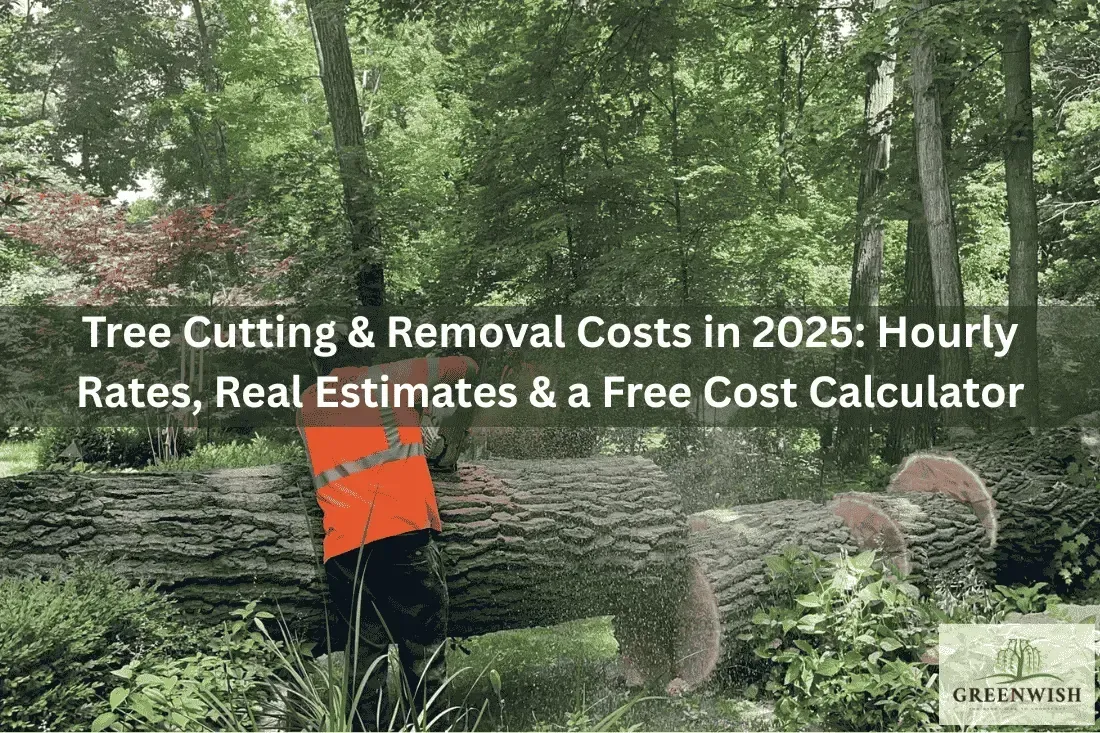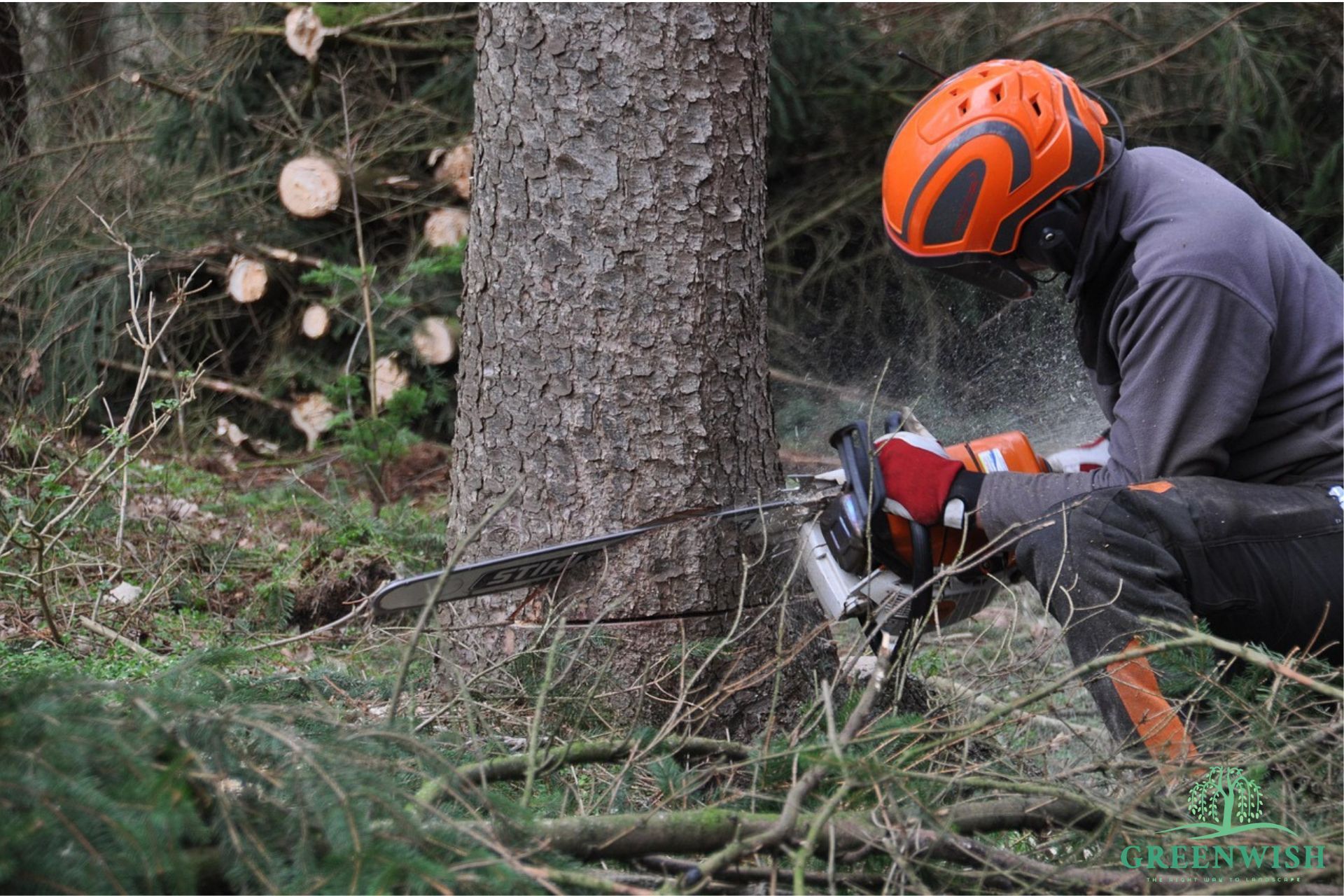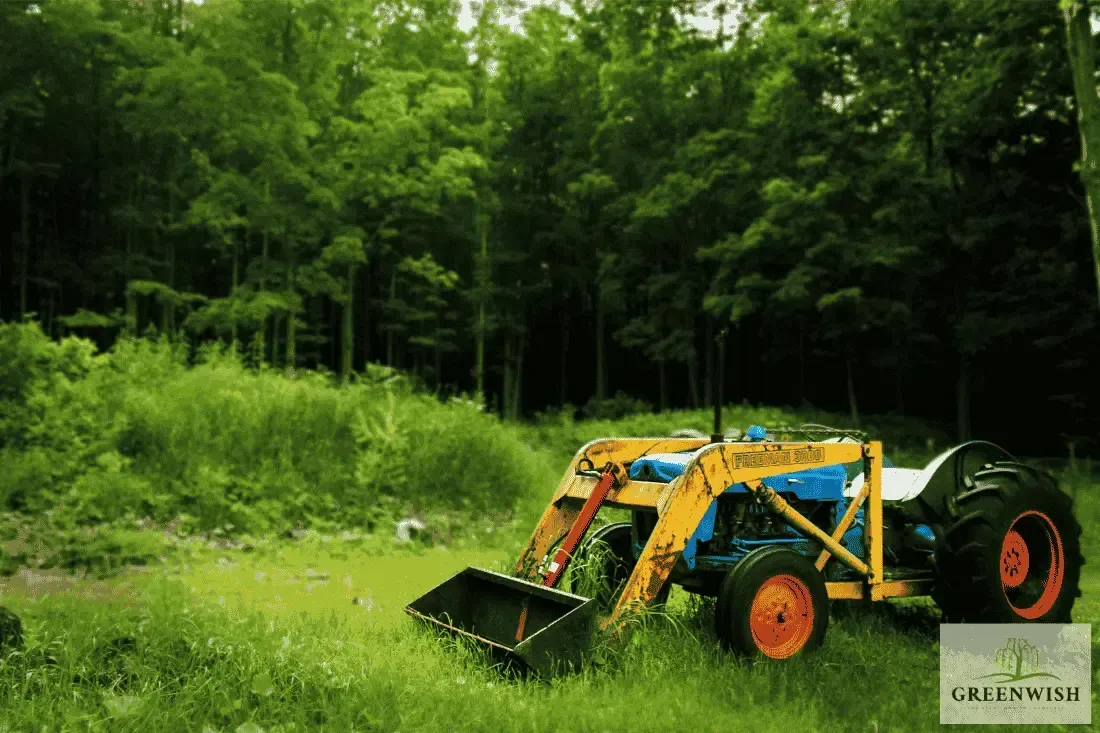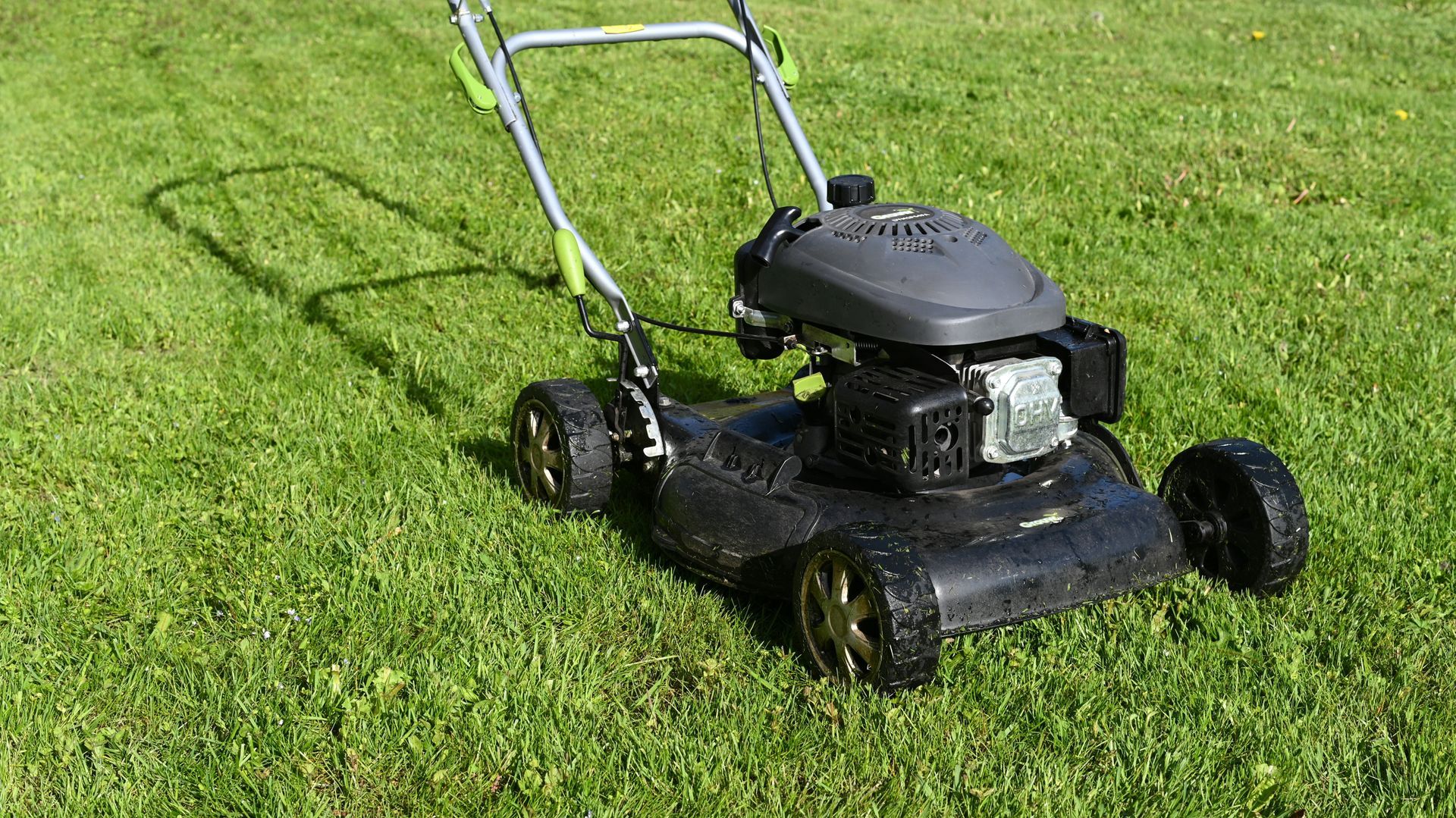Tree Cutting & Removal Costs in 2025: Hourly Rates, Real Estimates & a Free Cost Calculator

Why Tree Removal Isn’t Cheap—And Why You Should Still Budget for It
Here’s the thing about trees: they’re either quietly doing their job, or they’re one storm away from crashing into your roof and turning into a five-figure problem.
Tree cutting isn’t like mowing a lawn. It’s dangerous, gear-heavy, and time-consuming. And in 2025, prices are only climbing—thanks to rising labor costs, stricter safety standards, and the kind of liability that makes insurance companies sweat.
If you're wondering what it’ll cost to trim a few branches or remove that 100-foot pine slowly leaning over your shed, you’re in the right place. This guide breaks down real numbers, hourly rates, and even gives you a cost calculator so you’re not guessing in the dark.
We'll cover:
- How much tree removal costs (and why it varies so much)
- Hourly vs. per-job pricing
- What factors drive up your quote
- When to hire (and when to wait)
- And what you need to ask before signing anything
Let’s break it down.
What’s the Real Tree Cutting Service Cost in 2025?
So, let’s answer the question everyone types into Google: “How much does it cost to cut down a tree in 2025?”
Short answer: it depends. But here’s a realistic range.
- Small trees (under 30 ft): $150 to $500
- Medium trees (30–60 ft): $400 to $1,200
- Large trees (60–100+ ft): $1,000 to $2,500+
- Emergency tree removal? Add $200 to $1,000 easily.
Now, if you’re dealing with a 100-foot pine or anything tangled with power lines, that’s a whole different beast. Specialized equipment, permits, and additional crew time can send your cost well past the $3,000 mark.
Why the wide range? Because no two tree jobs are the same. Some are a one-saw-and-done situation. Others require cranes, traffic control, and a certified arborist.
And don’t fall for the “$50 flyer guy” — liability insurance alone is a big chunk of a legit company’s cost. You're not just paying for someone to cut wood. You're paying for not getting sued if something goes wrong.
Tree Cutting Service Cost Per Hour in 2025
If you’ve ever been quoted hourly instead of per tree, here’s what’s going on.
In 2025, most professional tree removal crews charge between $90 and $200 per hour. That rate usually includes a two-person team, chainsaws, safety gear, and a chipper truck. Larger jobs may require more crew and equipment, which can push that hourly rate even higher.
Hourly pricing makes sense for:
- Clearing multiple small trees
- Trimming branches across different areas of a property
- Hauling debris after a storm
But here's what people forget: time adds up fast when you're dealing with obstacles like fences, power lines, or tight spaces. What seems like a two-hour job on paper could turn into five if the crew has to take it down in pieces.
If you're quoted an hourly rate, ask what’s included. Does it cover debris removal? Is stump grinding extra? Is travel time part of the bill?
Because nobody wants a surprise charge for “equipment loading” or “wood hauling” at the end.
What Affects Tree Cutting and Removal Costs?
Not all trees are equal, and neither are their removal costs. A 20-foot birch in your front yard is not in the same category as a massive, dying oak wedged between power lines out back. Here’s what really drives the price up—or keeps it reasonable.
Tree size and height
The taller and wider the tree, the more time, labor, and risk involved. Cutting a 25-foot tree? Straightforward. A 100-foot pine with deep roots? That’s a project.
Location matters
Trees close to your house, power lines, fences, or neighbor’s property require more precision, which means more time and higher risk. If a crane has to be brought in, your price just doubled.
Tree health
Dead or rotting trees are unpredictable. Crews have to be extra cautious because the structure is weaker, which can lead to extra setup time or different cutting methods.
Type of tree
Hardwoods like oak or walnut are tougher to cut and remove than softwoods like pine. Denser wood means heavier logs, more strain on equipment, and slower cleanup.
Stump removal
Some quotes include stump grinding. Some don’t. If you want that stump gone completely, expect an extra $100 to $400 depending on the size.
Cleanup and hauling
Leaving a pile of logs behind costs less. Want everything chipped, cleaned, and gone? You’ll pay for that convenience.
Urgency
If a tree is leaning dangerously or blocking access after a storm, that’s an emergency call. Emergency pricing is real, and it’s usually 20% to 50% more.
Coming up next: how to estimate your tree cutting job before someone else names the price for you. Want me to move forward?
How to Estimate a Tree Cutting Job Yourself
Before calling a crew, you can do a quick back-of-the-napkin estimate to avoid getting blindsided by the quote.
Here’s what to look at:
1. Height and spread of the tree
Is it 30 feet or 80? Broad like an oak or narrow like a pine? Tree size is the starting point, and most costs scale up from there.
2. Location
Is it in an open yard with space to drop it cleanly? Or is it leaning over your garage with power lines nearby? That changes the game completely.
3. Accessibility
Can the crew drive right up to the tree, or will they need to carry logs through a narrow gate or over a hill? If equipment can’t reach the site, you’re looking at more hours and more cost.
4. What needs to be done?
Just cutting? Or full removal, stump grinding, and debris hauling? Break the job into parts so you can understand where the money’s going.
5. Hourly vs. flat rate
Ask both types of quotes if possible. Hourly can be cheaper for simple jobs. Flat rates give more certainty for complex ones.
Use a calculator
Online tools like a
Tree Cutting Service Cost Calculator or Tree Removal Cost Estimator can give you a ballpark figure before you bring in quotes. They’re not perfect, but they’re better than guessing blindly.
Why Tree Removal Costs What It Does
Tree cutting isn’t just a guy with a chainsaw and a truck. It’s a mix of skilled labor, heavy equipment, permits, insurance, and calculated risk.
1. Skilled labor isn’t cheap
This isn’t something you can YouTube and wing. Certified arborists train for years, especially to handle risky or diseased trees. They also carry liability insurance—because if something goes wrong, it can go very wrong.
2. Equipment costs
You’re not just paying for a chainsaw. You’re covering cranes, climbing harnesses, wood chippers, stump grinders, and the fuel to run them. All of it adds up fast.
3. Risk and liability
Felling a 60-foot oak next to a house? One bad move and someone’s roof, car, or life is at risk. That level of danger is factored into the cost—just like in any high-risk job.
4. Time and complexity
Not all jobs are straight-up cut and drop. Some require rigging branches down in pieces, dealing with storm damage, or working in tight quarters. More time equals more money.
5. Hauling and disposal
Some crews leave the mess behind. Others clean, chip, haul, and sweep. The more cleanup you want, the more you’ll pay.
In short: tree removal isn’t overpriced—it’s just more complex than most people realize.
Real-World Tree Cutting and Removal Prices in 2025
Let’s stop guessing and look at the actual costs people are seeing this year. Keep in mind, prices vary by location, tree type, and complexity—but here’s what you can expect.
Small Trees (under 30 feet)
Cutting Only:
Around $150–$400
Full Removal:
$300–$800
Examples:
Ornamental trees, smaller maples, dogwoods
Medium Trees (30–60 feet)
Cutting:
$400–$900
Removal:
$700–$1,500
Think:
Bradford pears, mature birches, decent-sized pines
Large Trees (60–100 feet)
Cutting:
$800–$1,500
Full Removal:
$1,200–$3,000
Includes:
Tall pines, mature oaks, large sycamores
Very Large Trees (100+ feet)
Now you’re entering crane territory.
Cost to remove a 100-foot pine tree? Easily $2,500–$5,000, depending on location, access, and risk.
These estimates include labor, some equipment, and basic cleanup. If you want stump grinding, hauling, or emergency service, those are add-ons.
Pro tip: If your tree removal quote is suspiciously low, ask about insurance and cleanup. Cheaper doesn’t always mean better—sometimes it just means “you’re on your own if things go south.”
Is There a “Cheapest” Time for Tree Removal?
Actually, yes—and it has less to do with the tree and more to do with the calendar.
Winter and late fall are when most tree service companies slow down. Trees are dormant, the leaves are gone, and crews have more availability. This off-season window usually means better rates and faster scheduling. Some companies even offer winter discounts to keep their teams busy.
Summer and spring? That’s peak season. Storm damage, overgrowth, and landscaping demand drive prices up. If you're in no rush, waiting until the cold sets in could save you a few hundred bucks—especially on big removals.
One more thing. In dry climates or during fire seasons, cities might offer subsidies or incentives for removing high-risk trees. It's rare, but worth checking with your local municipality.
Will Insurance Cover Tree Removal?
Here’s the thing: sometimes yes, most times no.
If a tree falls because of a storm, and it hits your house, car, or blocks a driveway, your homeowners insurance might cover the removal. But if that same tree is just dead, leaning, or ugly? That’s your problem.
Most policies only kick in when there’s actual damage or immediate danger involved. You’ll need to check your policy—or better yet, call your provider and ask them directly. And get it in writing.
One more tip: if your area just got hit by a major storm, don’t wait. Tree services get flooded with calls, and insurance-approved contractors book up fast.
Does Tree Removal Hurt or Help Property Value?
It depends on the tree—and the story it's telling.
If the tree is healthy, placed well, and adds shade or curb appeal, cutting it down might actually lower your property’s value. But if it’s too close to the house, blocking sunlight, dropping sap on cars, or clearly dying? Removing it can be a selling point, not a setback.
Buyers notice things like overgrown roots cracking driveways or limbs hanging over roofs. They also love open, usable yards. So if you're debating whether to cut that monster down, think about how it looks to someone buying your house, not just how it feels to lose it.
How Do Tree Services Actually Price a Job?
There’s no magic formula. It’s part science, part street smarts, and a whole lot of experience.
Tree companies usually consider five things:
- Size of the Tree
– Bigger tree, bigger tools, more people, more time. Simple.
- Location
– Is it hanging over a house? Wedged between power lines? Hidden in a backyard with no truck access? That’s going to cost you more.
- Type of Tree
– Softwoods like pine are easier to cut. Dense hardwoods like oak or maple? Those take longer and beat up equipment.
- Complexity
– Will they need a crane? Is the tree rotting inside? Are they climbing it or using a lift? The trickier it is, the higher the price climbs.
- Cleanup
– Hauling logs, grinding stumps, raking debris—it’s not always included, and it can add hundreds to the total.
Some companies charge by the hour. Others offer fixed rates based on a site visit. If you’re being quoted without anyone actually seeing the tree? Red flag.
Tree Removal and Cutting Hourly Rates in 2025
Let’s talk money.
On average, tree cutting services in 2025 charge between $75 to $150 per hour per worker. If heavy equipment like cranes or bucket trucks are involved, expect that number to climb—sometimes hitting $250+ per hour.
But remember, hourly rates don’t always tell the full story. A skilled team with the right tools might finish a job in half the time of a cheaper crew. Always get a full estimate, not just an hourly quote, and make sure it includes cleanup.
How Much Does It Cost to Remove a 100-Foot Tree?
Short answer: it’s not cheap.
Removing a massive 100-foot tree can cost anywhere from $2,500 to over $5,000, depending on where it’s located, how risky the removal is, and what kind of equipment’s needed. Trees that tall usually require cranes, multiple crew members, and serious cleanup efforts.
If it’s leaning, dead, or close to structures or power lines, expect the quote to push higher. You're not just paying for labor—you’re paying for the risk and precision.
When’s the Cheapest Time to Remove a Tree?
Winter. That’s usually your best bet.
Why? Trees are dormant, the ground is firmer, and demand drops—so many companies offer off-season pricing. You’re not competing with spring cleanup rushes or storm damage emergencies.
Plus, frozen soil can make it easier for crews to bring in heavy equipment without tearing up your yard. If your tree isn’t a safety hazard and can wait, book it between late December and early March. It might save you hundreds.
Does Homeowners Insurance Cover Tree Removal?
It depends on why the tree has to go.
If a tree falls on your house or garage due to a storm, most standard policies will cover the removal—up to a limit. But if it’s dead, dying, or just making the yard look ugly? That’s on you.
Also, insurance usually doesn’t pay for removal unless the tree actually causes damage. Just being at risk isn't enough. Always call your provider before scheduling anything—they’ll tell you what’s covered and what’s not.
Does Removing Trees Hurt or Help Property Value?
It depends on what kind of tree you’re removing—and why.
If a tree is dead, leaning, blocking sunlight, or threatening your foundation, getting rid of it can actually boost your property value. Buyers don’t want to inherit problems. But if you cut down a healthy, mature tree that adds curb appeal or shade? That could hurt.
Bottom line: remove what’s dangerous, keep what’s beautiful. And when in doubt, talk to a local real estate agent or arborist before making the call.
FAQs About Tree Cutting & Removal Costs
How much do people charge for cutting trees?
Most jobs fall between $300 to $2,500, depending on the tree's size, location, and risk factor. The national average sits around $700 to $1,200 for standard removals.
How do I estimate a tree cutting job?
Start with the height and condition of the tree. Add difficulty—like proximity to buildings or power lines—and whether special equipment’s needed. Always get multiple quotes, and make sure cleanup is part of it.
Why is tree cutting so expensive?
Because it’s dangerous, labor-heavy, and requires skill. You’re not just paying someone to chop a tree—you’re paying for expertise, safety, and equipment. It’s also usually insured work, which adds to the cost.
How much does it cost to cut a 100-foot tree?
Between $2,500 to $5,000+. Size, location, and access make a big difference. Cranes, multiple workers, and disposal fees drive the price up.
Will homeowners insurance cover tree removal?
Only if the tree causes damage—like falling on a house or fence. Routine removal? That’s on your dime.
What’s the cheapest time of year for tree removal?
Winter, hands down. Lower demand, dormant trees, and sometimes discounted rates.
Does removing trees decrease property value?
It can—but not always. If the tree is hazardous, it’s a smart move. But cutting down a beautiful, healthy tree in the front yard? That could make your home less attractive to buyers.

















